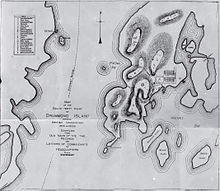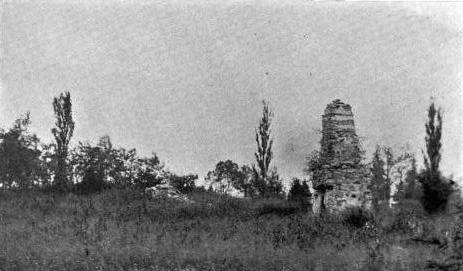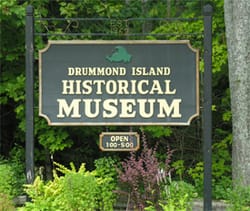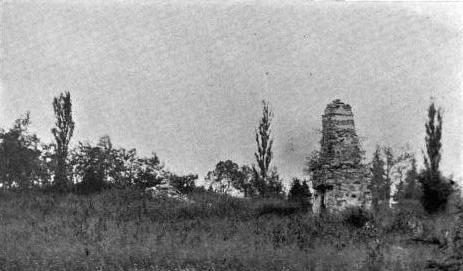
Fort Drummond was a fort built on Drummond island which is part of the UP of Michigan. The fort was built during the late stages of the war of 1812 and didn’t serve many purposes during the war. The remains can be seen at the local museum today.
What the Fort was
Fort Collyer, later known as Fort Drummond, was built during the war of 1812 after the Brittish evacuated from Mackinac in 1815. Under Brittish general McDonall, the British forces and some civilians took years to find a location to build the fort. The Brittish stayed on Drummond island for several years after the war utilizing the position for convenient trade with local Indian tribes. When the area was actually charted to distinguish borders between Canada and the U.S. Britain had to flee from the fort to avoid another conflict with the United States.[1] The fort was never finished due to lack of funding, the uncertainty of who’s land Drummond island was and was ultimately abandoned in 1828 by the American forces because the fort served no strategic purpose for the military and the U.S. didn’t want a standing army in that point of history. Nothing really happened at the fort as it was only used for trade with Indian tribes and shelter during winter seasons. The fort was built differently from other forts and can be seen as remains of the past today. The fort is unknown to many because nothing interesting happened at the fort and it was located in the middle of basically uncharted areas in the UP. Locals of Drummond Island opened what was left of the remains of the fort for tourists after a private individual bought the land for a museum. The museum’s private property holds what is leftover from the fort many other relics of the area throughout the foundation of the city and earlier with artifacts from ancient native American tribes. Although the fort served very little purpose during the war of 1812 it is interesting to study early time periods of our country and try to get insight as to what the early stages of America were like.
The Fort’s construction and description
Fort Drummond, at the time, was fort Colyer, was built in 1815 after the British general McDonall retreated from fort Mackinac in 1815. The fort had very little funding from the Brittish army having very few actual military structures in the fort. During the construction, winter hit and stalled the building process of the fort as well as killing some soldiers. Fort Drummond was built on the coast of Whitney bay on Drummond Island. The fort was an assortment of houses for civilians and soldiers with very little actually built. The fort had small buildings called bark lodges made out of cedarwood and small poles for support and didn’t really have much as far as the quality of life features like chimneys, fireplaces, and kitchens. These were the newer houses that were nicer but would degrade fast[4]. The fort had large buildings made with kitchens and chimneys being nicer than the other buildings and 2 stories for the general and his battalion leaders. The 2 story buildings had kitchens without ovens, fireplaces and stone reinforcements. The rest of the houses were typically timber wood with little stone. The fort also had a lime quarry for the stone on the fireplaces and kitchens. Today remains of the buildings with the stone can still be seen but have very little left after being abandoned. The design of the fort was spread out having many housing areas separated by soldiers on the west and civilians with general cooking areas and the nicer buildings near the east side and center of the fort. To the south of the fort was the quarry. No walls were installed on the fort because the location was unclear during the war and Brittan didn’t expect an attack on the fort without reaching ships in the bay. The northern portion of the fort was the sawmill for the timber logged style cabins most of the houses were designed as. The lumber yard is used today as one of the biggest lumber yards on Drummond Island.
Why Fort Drummond was built

The fort was built because the British wanted a fort by Mackinac for trading and defense. The British trade with the native’s resources for fur. The Prominent tribes in the area were the Menomini, Chippewa, and Ojibwa.[7] The Menomini tribe was the most prominent tribe in the UP holding the majority of the area. Other tribes were located on the upper portion of Michigans lower Panninsula and some of the islands on the tail of the UP. The Menomini and other local tribes had a treaty with the Brittish at the time. Drummond was a strategic point as it was close to Mackinac, a previous Brittish held for in Michigan to help defend Canada and the native tribes up there.[2]The Brittish saw the Indian tribes as an asset against the American army and valuable for trading with. The search for the location took years to find as general McDonall wanted to find a good strategic point for the fort. He ultimately chose an unnamed island later called Drummond island. The place McDonnall chose was the southwest tip of Drummond Island, One of the islands on the eastern side of the Upper Peninsula of Michigan (UP). After settling on the location of the fort he named the fort Colyer or Colier depending on the historian. The fort was built cheaply as to not have to dedicate unnecessary resources to a territory that may have been Americas after the treaty of Ghent.
The use of Fort Drummond

The use of the fort was mainly housing for soldiers and civilians in the area and under the command of general Mcdonall. Mcdonall was forced to retreat fort Mackinac on May 15, 1815, by the American army. His forces searched for years before finding Drummond island. The fort didn’t get much use outside of housing and trade for the short time it was in use. The location allowed the Brittish to trade with. After general McDonall learned of the treaty of Gent officially ending the war of 1812, he didn’t leave. The location of the island wasn’t known and was unclaimed for some time. The Brittish didn’t want to spend too many resources if the structure was on American soil so the fort was underdeveloped and not useful outside of trading. The fort averaged 300 to 450 people during the construction and had many go back to Britain after the war [1]. McDonall did not want to leave the fort for some time as the fur trade was valuable. He also didn’t like the relations between America and the local Indian tribes. Many tribes and America had common conflicts before the revolutionary war and were still frequent before and after the war of 1812. He wished to keep good relations through trade in the area and elected to stay even after learning about the treaty of Ghent. McDonall didn’t learn of the treaty of Ghent until after building the fort but still elected to stay until it was certain the land was Americas. Many of the soldiers under general McDonall returned home during the occupation of the island after it was known that Brittan was no longer at war with the United States. He later resigned from the role in 1816. The fort was put under different commanders throughout its use not really having a steady commander for many years. Lt. Col. Maule took control of the fort after general McDonall and stayed until 1817. After 1817 the control changed hands twice from Major Thomas Howard followed by Major James Winnett going to 1822. During these years the Brittish traded with the natives but never really added to the fort and hunkered down during the winter but didn’t really get much use outside of housing and trade. During these years it was still unclear whos land Drummond island was as the location was still unclear at the time. It was discovered during 1822 that the island was American soil. The British were reluctant to leave as the fur trade was valuable for the civilians and Britain at the time.
Command of Fort Drummond
The Brittish knowing the land was owned by America put Major Goff in charge in 1822. Major Goff was replaced by Lieutenant James J. Gaston in June 1824. After 1827 the Brittish started looking for a place to relocate that was not owned by the Americans. June 1827 fort Drummond was finally put under the command of the last Brittish leader for the fort who was Lieutenant Thomas Carson. Lieutenant Carson remained in for Drummond for about a year before America forced them to leave Drummond island and the UP. The Brittish troops fled fort Drummond leaving most of the food, furniture, and personal belongings as they didn’t have the space to ship their stuff. The Americans seized most of the stuff left behind by the British. The troops under Lieutenant Thomas Carson fled to Penetanguishene abandoning the old Brittish fort. After the Brittish left, the fort didn’t see much use. Lieutenant T. Pierce Simonton officially took control of the fort on November 14, 1828, and named it fort Drummond.[4] Simonton and his forces never occupied the fort and eventually abandoned it with the civilians who remained after the winter. Some civilians remained in the area to start a new American colony. That was the last time the for was used outside of the lumber yard and quarry. The fort was left abandoned for many years. The American troops abandoned the fort after the winter because the U.S, at the time of after the war of 1812 dispanded much of the standing army because there was no need for the army outside of war at the time. The remanents of the fort suggest it was burned down by a forest fire sometime after but is uncertain as no one returned to the fort for many years. The fort was made a historical marker in the 1920s, 1924 to be exact, by the local town that stayed nearby after the U.S. army left. The Finnish colony started a town being part of the U.S. and one of the few towns on Drummond Island. The local people built a museum for local attraction and income in 1924 and was only available by ferry. The museum contains the entirety of the forts remains and has put efforts to preserve the remains. The fire damage burnt down most of the fort but has the buildings made with the stone still partially standing.
Drummond Island Museum

The area of the fort was a historical marker starting from 1924. The fort was found and opened up to the public to see on May 17th, 1959 [3]. The fort was sold not to long after and sold to the family that owns the museum nearby. The museum is currently owned by the Seaman family after Daniel Seaman and his wife Elizabeth Seaman bought the land putting their house directly across the street of the museum [6]. The museum is currently privately owned and open for viewing as a nonprofit organization. The museum holds Indian relics from 200B.C. and remains of the fort within the building. The native American relics are from the Menomini tribe. Tours of the fort are currently available through the Drummond island tour guide website. The museum is free to explore and tour from only accepting donations to keep it running and logging sponsors from the area. The other interest point of the museum is the Finnish colony founded by Maggie Walz around the time the fort was abandoned. The colony built itself by the fort using the quarry and lumber mill even after the majority of the fort burned down from a forest fire. No records indicate when or why the fire started. The only evidence is scorching on the stone building’s remains and scorched wood in the area. The fort’s relative uselessness during the war has made the fort forgotten by most and led to the abandonment of the fort entirely in 1829. The museum is the only place where the remains are located and able to be seen.
Primary Sources
1. Carroll, F. (2004). The Search for the Canadian-American Boundary along the Michigan Frontier, 1819-1827: The Boundary Commissions under Articles Six and Seven of the Treaty of Ghent. Michigan Historical Review, 30(2), 77-104.
2. Robert McDonall to Major Foster. (1815). Mississippi Pioneer and Historical Collections, 16 (1890) 325-327.
3. THE TRIBUNE TRAVELERS’ GUIDE: Fort Colyer, Britain’s Last U.S. Post, Is Link with Past Site Is Reached by Ferry.Chicago Daily Tribune. (1923-1963). The Tribune Traveler’s Guide (1959, May 17).
Secondary Sources
4. Drummond island: The Story of the British Occupation.1815-1828 Cook, Samuel F. (1896).Drummond Island; The Story of the Brittish Occupation
5. REMAINING OPPORTUNITIES ALONG THE MICHIGAN UPPER PENINSULA National Park Service. (1959). Great Lakes Shoreline Recreation Area Survey
6.“Drummond Island Historical Museum.” Drummond Island Tourism Association
7.“Fort Drummond Burial Ground in Drummond, Michigan – Find A Grave Cemetery.” Find A Grave

